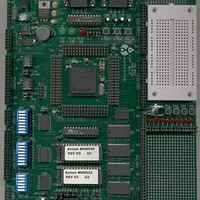MPC555CME Freescale Semiconductor, MPC555CME Datasheet - Page 698

MPC555CME
Manufacturer Part Number
MPC555CME
Description
KIT EVALUATION FOR MPC555
Manufacturer
Freescale Semiconductor
Type
Microcontrollerr
Datasheet
1.MPC555CME.pdf
(966 pages)
Specifications of MPC555CME
Contents
Module Board, Installation Guide, Power Supply, Cable, Software and more
Processor To Be Evaluated
MPC555
Data Bus Width
32 bit
Interface Type
RS-232
For Use With/related Products
MPC555
Lead Free Status / RoHS Status
Contains lead / RoHS non-compliant
- Current page: 698 of 966
- Download datasheet (13Mb)
21.2.1 Program Trace Cycle
MPC555
USER’S MANUAL
Instructions are fetched sequentially until branches (direct or indirect) or exceptions
appear in the program flow or some stall in execution causes the machine not to fetch
the next address. Instructions may be architecturally executed, or they may be can-
celed in some stage of the machine pipeline.
The following sections define how this information is generated and how it should be
used to reconstruct the program trace. The issue of data compression that could re-
duce the amount of memory needed by the debug system is also mentioned.
To allow visibility of the events happening in the machine a few dedicated pins are
used and a special bus cycle attribute, program trace cycle, is defined.
The program trace cycle attribute is attached to all fetch cycles resulting from indirect
flow changes. When program trace recording is needed, the user can make sure these
cycles are visible on the external bus.
The VSYNC indication, when asserted, forces all fetch cycles marked with the pro-
gram trace cycle attribute to be visible on the external bus even if their data is found
in one of the internal devices. To enable the external hardware to properly synchronize
with the internal activity of the CPU, the assertion and negation of VSYNC forces the
machine to synchronize. The first fetch after this synchronization is marked as a pro-
gram trace cycle and is visible on the external bus. For more information on the activity
of the external hardware during program trace refer to
In order to keep the pin count of the chip as low as possible, VSYNC is not implement-
ed as one of the chip’s external pins. It is asserted and negated using the serial inter-
face implemented in the development port. For more information on this interface refer
to
Forcing the CPU to show all fetch cycles marked with the program trace cycle attribute
can be done either by asserting the VSYNC pin (as mentioned above) or by program-
ming the fetch show cycle bits in the instruction support control register, ICTRL. For
more information refer to
When the VSYNC indication is asserted, all fetch cycles marked with the program
trace cycle attribute are made visible on the external bus. These cycles can generate
regular bus cycles (address phase and data phase) when the instructions reside only
in one of the external devices. Or, they can generate address-only cycles when the
instructions reside in one of the internal devices (internal memory, etc.).
When VSYNC is asserted, some performance degradation is expected due to the ad-
ditional external bus cycles. However, since this performance degradation is expected
to be very small, it is possible to program the machine to show all indirect flow chang-
es. In this way, the machine will always perform the additional external bus cycles and
maintain exactly the same behavior both when VSYNC is asserted and when it is ne-
gated. For more information refer to
21.5 Development Port
• The number of instructions canceled each clock
/
MPC556
21.2.5 Instruction Fetch Show Cycle Control
DEVELOPMENT SUPPORT
Rev. 15 October 2000
21.7.6 I-Bus Support Control
21.2.4 The External
Register.
Hardware.
MOTOROLA
21-2
Related parts for MPC555CME
Image
Part Number
Description
Manufacturer
Datasheet
Request
R

Part Number:
Description:
MPC555 Interrupts
Manufacturer:
Freescale Semiconductor / Motorola
Datasheet:
Part Number:
Description:
Manufacturer:
Freescale Semiconductor, Inc
Datasheet:
Part Number:
Description:
Manufacturer:
Freescale Semiconductor, Inc
Datasheet:
Part Number:
Description:
Manufacturer:
Freescale Semiconductor, Inc
Datasheet:
Part Number:
Description:
Manufacturer:
Freescale Semiconductor, Inc
Datasheet:
Part Number:
Description:
Manufacturer:
Freescale Semiconductor, Inc
Datasheet:
Part Number:
Description:
Manufacturer:
Freescale Semiconductor, Inc
Datasheet:
Part Number:
Description:
Manufacturer:
Freescale Semiconductor, Inc
Datasheet:
Part Number:
Description:
Manufacturer:
Freescale Semiconductor, Inc
Datasheet:
Part Number:
Description:
Manufacturer:
Freescale Semiconductor, Inc
Datasheet:
Part Number:
Description:
Manufacturer:
Freescale Semiconductor, Inc
Datasheet:
Part Number:
Description:
Manufacturer:
Freescale Semiconductor, Inc
Datasheet:
Part Number:
Description:
Manufacturer:
Freescale Semiconductor, Inc
Datasheet:
Part Number:
Description:
Manufacturer:
Freescale Semiconductor, Inc
Datasheet:
Part Number:
Description:
Manufacturer:
Freescale Semiconductor, Inc
Datasheet:










